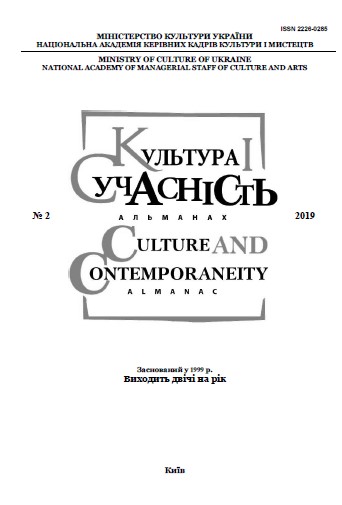INTONATIONAL-SEMANTIC ASPECTS OF THE IMPLEMENTATION OF THE IMAGES OF GLORIFICATION-PRAISE IN THE GERMAN PROTESTANT MUSICAL AND HISTORICAL TRADITION
INTONATIONAL-SEMANTIC ASPECTS OF THE IMPLEMENTATION OF THE IMAGES OF GLORIFICATION-PRAISE IN THE GERMAN PROTESTANT MUSICAL AND HISTORICAL TRADITION
Author(s): Anzhelika Anatoliyivna TatarnikovaSubject(s): Christian Theology and Religion, Cultural history, Music, 18th Century, 19th Century, History of Art
Published by: Національна академія керівних кадрів культури і мистецтв
Keywords: Protestant choral; "Te Deum"; "Gloria"; Reformation; German culture; "theology of glory"; "theology of the cross;
Summary/Abstract: The purpose of the article is to identify the intonational-semantic specifics of the implementation of praiseglorification images in the German Protestant liturgical and singing and creative musical and historical traditions. The methodology of the work on the intonation concept of music from the perspective of stylistic, etymological analysis, as well as on interdisciplinary and historical-cultural approaches that allow revealing the spiritual-semantic and genreintonational features of the interpretation of the designated figurative sphere of German spiritual culture and music. The scientific novelty of the article is determined by the fact that it first generalized the poetic-intonational specificity of depicting praise-glorification images in line with the religious attitudes of Lutheranism ("theology of glory," "theology of the cross"), as well as the work of German composers of the 18th-19th centuries. Conclusions. Glorious-glorious themes occupy one of the essential places in European Christian culture, in particular, in German Protestant, defining the vectors of its spiritual and semantic orientation. Genetically dating back to the Byzantine Eastern Christian tradition and to the spiritual precepts of the early Middle Ages of the Undivided Church, the confessional tradition in translating the images of praise and glorification («Te Deum» and «Gloria» in their German version) was formed at the intersection of the Protestant doctrines of «theology of glory» and «theology of the cross». The intonational-semantic specificity of Lutheran chorales associated with the designated figurative-semantic sphere demonstrates contact with a variety of confessional Christian traditions – Catholic (appeal to the intonational material of Gregorianiс), Eastern Christian (appeal to the spiritual texts of the early Middle Ages), thereby revealing the specificity of spiritual and creative German composers of the 18th-19th centuries
Journal: Культура і сучасність
- Issue Year: 2019
- Issue No: 2
- Page Range: 63-69
- Page Count: 7
- Language: English

